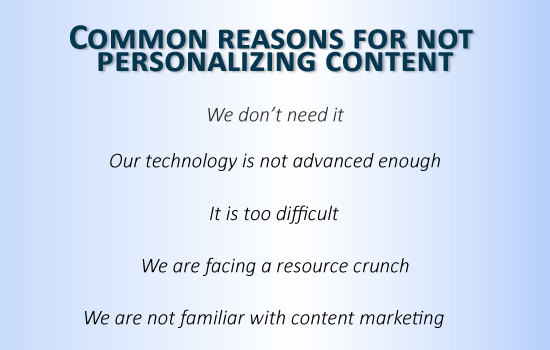
“Remember that a person’s name is, to that person, the sweetest and most important sound in any language.” – Dale Carnegie
Imagine these scenarios:
- Physicians who routinely prescribe off-label drugs receive email updates from you on FDA regulations around the use of off-label medicines.
- Discussions are initiated around the molecule of your soon-to-be-launched product and insights thus obtained are used to develop customized content aimed at different doctor groups when it is launched.
- Physicians who have recently relocated to a new state receive SMS reminders about your CME courses to help them fulfill that state’s medical practice requirements.
This is not a case of pharma marketers’ imaginations gone wild, but a reality, made possible by advanced technology. In this digital age, best pharma marketing practices no longer include organizing the grandest seminars or giving the fanciest gifts but being able to offer physicians a highly-personalized engagement experience through relevant, actionable content. However, pharma’s overreliance on conventional marketing techniques has led it to ignore a treasure trove of information on specific content needs of the medical community, widening the gap between what doctors want and what pharma companies offer.
Attention Pharma – Personalize or Perish!
Technological advancements are creating never-before-imagined engagement possibilities for marketers. The onslaught of digital media and its widespread acceptance by physicians has left pharma marketers with little choice but to customize their marketing communication to suit the requirements of specific individuals and groups. With physicians getting used to having their information needs assessed and fulfilled without even demanding, the future of one-size-fits-all engagement (that most offline approaches adopt) looks grim.
Why Personalize?
- Better Engagement – Harvard Business Review notes ‘stand out from the crowd’ as a high-impact emotional motivator that drives consumer behavior. It’s an amazing feeling for physicians to know that their problems, interests and choices are taken care of without even asking for it. And what better way to do this than present them with the precise clinical information that they having been seeking, right on their device of choice. Personalization is an effective tool for moving users through the marketing funnel and has become the mainstay of relationship-driven marketing.
- Cutting through the Noise – Personalized content plays a huge role in reducing information overload (or the perception of it). By not filtering content as per doctor’s needs, you are drowning the already-busy professional in a deep pool of information, navigating through which will leave him/her devoid of all time and energy, and ultimately disappointed with your engagement initiatives.
- More Bang for Your Buck – Governmental measures like price caps on drugs and medical devices, promotion of generics over branded drugs and imminent restrictions on traditional marketing practices (UCPMP Act) have led to a VUCA environment for the pharma industry. It has never been more important for marketers to optimize their resources. Personalization can help make every rupee count by using it for the right purpose, for the right person, and at the right time.
Despite these obvious benefits of personalization, a majority of pharma companies continue to adopt a largely blanket approach to physician engagement.
What’s Your Excuse for Living in the Dark Ages?
Research by Econsultancy shows that although 74% of marketers recognize the direct correlation between personalization and customer engagement, only 19% actually practice it.

Poor pace of digitization is the biggest reason for pharma marketers not being able to adopt personalizing marketing techniques. For those who have gone the digital way, following factors act as roadblocks –
- Technological ineptness – Superior technology is fundamental to content personalization. However, most pharma companies do not use it due to reasons ranging from poor awareness to lack of top-level commitment. This deprives them of gaining relevant insights into physicians’ opinions and content needs across channels like email, social, mobile, etc. Many feel overwhelmed by the staggering amount of data that is generated on a daily basis, which can be made usable only by the efficient application of sophisticated technology.
- Lack of expertise – A huge problem facing pharma marketers today is not the inadequacy of data, but the resources to analyze it to their advantage. Most organizations struggle to mine data in a way that they understand information gaps so that suitable content may be devised.
- Content creation challenges – True personalization involves the offering of emotionally-engaging, contextually-relevant content. However, it is not easy to consistently create appealing content based on behavioral and attitudinal data. Also, most marketers struggle to scale their customization efforts to fulfill needs of various audience groups.
Becoming the Amazon for Doctors
An epitome of personalized marketing, Amazon’s ability to accurately assess customers’ needs is unparalleled and one of the key reasons behind its success. To replicate the same in pharma, marketers should follow these best practices:
- Capture Qualitative and Quantitative Insights – Deep analysis of qualitative and quantitative data is necessary to gain an all-round understanding of your target audience’s content needs. Some examples of questions that can be answered through digital interactions are, ‘What do cardiologists feel about the new drug to treat hypertension? ‘Do general physicians and orthopedics follow the same therapeutic approach to treat frozen shoulder? What content format is most suitable for marketing your new product to tech-savvy millennial doctors? Thorough mindset analysis lays the foundation for a successful content personalization strategy.
- Choose the Optimal Route to Personalization – There is no dearth of ways to offer users a highly-personalized experience. However not all fetch the best results or are worth the efforts. Marketers should make a judicious choice from options like call-outs, information bars, surveys and interactive polls, pop-ups, inline edits, etc. to deliver personalized messages. This choice should be driven by customer’s intent, context and motivation. It is important to remember that while it is great to tailor content as per specific needs, over-personalization could prove counter-effective.
- Segment Smartly – Digitization has opened up a wide array of ways to segment customers into relevant groups. However, it is necessary to carefully select the basis of segmentation. While some KOLs are keenly interested in clinical research, others are drawn towards medical symposiums. Some others may be actively involved in public health initiatives. Younger doctors want journal updates. General practitioners seek information on rare diseases. Only when your segmentation strategy takes into account these subtle differences in content needs, will your personalization efforts be truly effective.
- Create the Best Content (and distribute it well) – Great content is contextual, timely, actionable, and intuitive. In today’s digital world, it represents your company’s branding. A survey conducted by Docplexus reveals that 78% doctors prefer video content. 80% want medical write-ups to be limited to 2-3 scrolls for easy readability on mobile. While most marketers focus on creating more content, they often ignore efficient distribution of the existing content. A different content type for each stage of a doctor’s journey from the time he/she gets acquainted with your product to actually writing a prescription for it is highly recommended.
- Measure and Analyze – Personalized content will be worth the efforts so long as you effectively track and use the insights that your audience leaves behind across all touchpoints. It is essential to have a structured mechanism in place to continuously monitor and refine the strategy. Following metrics need to be tracked for this:
Quantitative Metrics:
Content Consumption – No. of views, no. of downloads, no. of webinars attended and other similar actions
Content Engagement – Session durations, comments, likes, shares, etc.
Qualitative Metrics: Attitudes and behaviors
- Last but not the least, align your online personalization strategy with your offline engagement initiatives – The best marketers ensure that their customers get a consistent experience across channels and hence adopt a comprehensive approach to content personalization.
